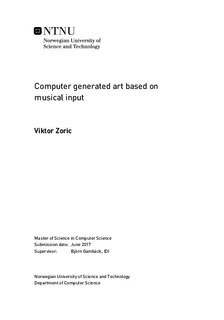Computer generated art based on musical input
Master thesis
Permanent lenke
http://hdl.handle.net/11250/2457135Utgivelsesdato
2017Metadata
Vis full innførselSamlinger
Sammendrag
This thesis explores computer-generated art based on musical input. The computer-generated art gives an end-user support in various life domains, which impose various aesthetic, artificial intelligence and software engineering goals and requirements. This thesis combines theoretical and practical approaches. It is a design, implementation and experiment-driven exercise and focuses on the use of evolutionary algorithms (EA) in image creation. End-user involvement and survey results contributed to the EA functionality, e.g. seeding techniques, fitness functions, mappings between genotype and phenotype information, etc. The EA for music-to-image transformation in this work operates on music and image metadata, rather than raw data. The metadata (for music and image features) is utilized by mapping tables, which work as recipes for images. This thesis uses EA to generate images by evolving the mapping tables without interactive involvement. Usage of metadata and mapping tables in EA introduces an alternative approach to computer generated image art, compared to the research body.Design tests and experiments focused on: (a) using mapping tables to match music and image features, and (b) experiments with various fitness functions that combined user preferences with art novelty aspects. The obtained experimental results and the end user interaction tests and evaluations, are promising and motivate for further development. Fitness functions based on a distance measure between user preferred mapping tables and the computer-generated mapping tables, can efficiently drive the EA towards the user s preference. Novel and interesting mappings between the image and music features can be achieved with fitness functions that selectively ignore some user preferences. Evolution of color palettes and figure parameters can match user expectations with reasonable time-usage without knowing the structure of the optimal mapping table.The developed software framework enables both future evolutionary algorithm improvements, and use of alternative AI approaches.
